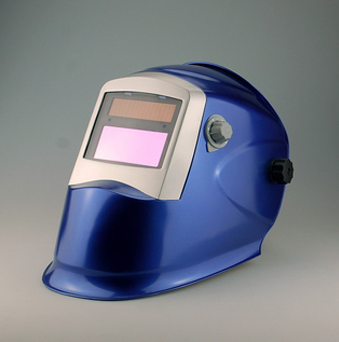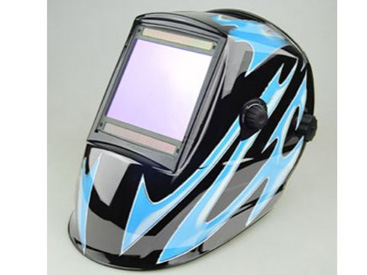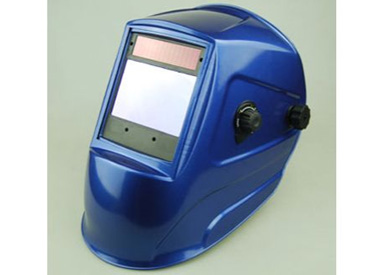Welding is an art that requires focus, craftsmanship and strong engineering skills. At Everlight Trade, we are committed to providing you with a full line of quality welding helmets.
Auto-darkening welding helmet is a necessary eye protection tool often used in the welding. With the improvement of people’s labor protection consciousness and the welding quality requirements, the original hand held fixed shading masks can not adapt to the requirements. Then what is the characteristics of auto-darkening welding helmet?

Auto-darkening Welding Helmet
The normal mask only has anti-ultraviolet ray or infrared ray lenses. Auto-darkening welding helmet has dual defense function, protecting welding workers' eyes. More over, the helmet uses materials with heat resistance, which can protect the user from the harmful radiation. The helmet protects welders' eyes from ultraviolet and infrared radiation all the time. This protection exists regardless of whether the lens is darkening or not.

Welding Helmet
If you always use a fixed material and a soldering process, then the fixed shade mask is ok. However, in most cases, welding workers need to use different welding methods for welding on different materials. Your best option is to use a auto-darkening welding helmet. Such masks can adjust the level of shading according to different special circumstances.
So what to consider when choosing an auto-darkening welding helmet?
ANSI Z87.1 and CSA Z94.3 standards
As long as you have an auto-darkening helmet that meets ANSI Z87.1 and CSA Z94.3 standards, your eyes should be protected from damage. Even when the lens isn't darkened, it still has built-in protection against infrared and ultraviolet light--and it's these things that can damage your eyes. However, the time it takes for the lens to darken can affect your comfort. Any quality helmet will dim within milliseconds, before your eyes have time to register the light from the arc. If you're doing only light welding, you might be fine with a less expensive helmet that has a lens reaction time rated at 1/3,600 of a second. But if you're spending the better part of a day on a welding project, a lens rated at that speed may still cause eye strain and fatigue. In cases like these, it's a better idea to choose a helmet with a faster reaction time. A helmet with a reaction speed rating of 1/20,000 of a second will keep your eyes more comfortable, even during longer days of working.

Auto-Darkening Welding Helmet
Switch between MIG and TIG
Some welding helmets with auto-darkening lenses automatically darken the lens to a #10 shade, which is a common shade for lenses with passive helmets. If you're mainly sticking to one type of welding, or if you keep the amperage consistent, this kind of helmet might be sufficient. But if you switch between MIG and TIG, for example, you may want to choose a variable shade helmet instead of a fixed shade one. These helmets have a range of shades, usually between #9 and #13. This allows you to still see what you're doing, even when the brightness of the welding arc changes.
While entry-level auto-dimming helmets may lack sensitivity and delay controls, these can be valuable tools. Adjustable sensitivity controls can allow you to choose what level of brightness the lens must detect before it darkens. If there are other welders nearby and you don't have adjustable sensitivity controls, their arcs might trigger your helmet's responses. In addition, if you're TIG welding, the lower amperages might not trigger a helmet with its sensitivity controls set too high.
Adjust the delay
Being able to adjust the delay is also useful. These controls allow you to adjust how long the lens remains dark after the arc stops. A shorter delay time can be useful when you're tack welding, since you can reposition the welder faster. For higher-amperage welding, a longer delay of up to a second may be preferable for allowing the puddle to cool.
Variety of viewing area sizes
Welding hoods are available with a variety of viewing area sizes. Ultimately, the size that you choose really comes down to which one you like best. However, larger viewing area sizes do have some benefits. With improved peripheral vision, you can get a better idea of where you are when you're working on larger weld assemblies. It also makes welding out of position easier.
Four sensors is ideal
Some inexpensive auto-darkening helmets are equipped with just one or two sensors. However, a helmet with four sensors is ideal. More sensors means more coverage. If there's a flash when you weld out of position, a two-sensor helmet may fail to register it and not darken. However, a four-sensor helmet is likely to catch any flash and darken the lens accordingly.
Batteries, solar panels for power source
Without a power source, your helmet won't do you much good. Usually, a helmet will use batteries, solar panels, or both. Using both is the best way to go, since the solar panels can help prolong the life of the battery.
The location of the controls
Another thing to take into consideration is the location of the controls. An external control panel allows you to change settings without removing the helmet, which can be handy. However, their positioning on the exterior means that they may suffer damage more easily. Internal controls are more protected, but less convenient to adjust.
We have been manufacturing and exporting Welding Machinery, Welding Consumable and Welding Component for more than 20 years. More information pls visit here.








